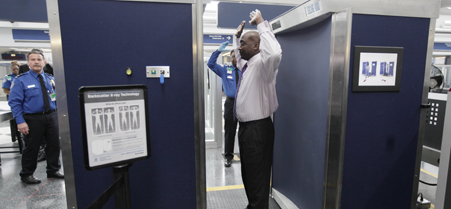TSA seeks auto-detection for controversial body scanners
The agency will continue to deploy the technology in major airports in fiscal 2011, officials say.
 031710scannerNGins
(Mar. 17) -
TSA says it will continue to implement body scanners to airports nationwide.
031710scannerNGins
(Mar. 17) -
TSA says it will continue to implement body scanners to airports nationwide.
The Transportation Security Administration will continue rolling out to airports nationwide controversial scanners that some say depict travelers' anatomical features too clearly, even as it improves the technology's efficiency and privacy features, government officials told a House subcommittee on Wednesday.
The image-scanning technology provides the same security as a passenger pat-down, but takes far less time to complete. The efficiency will improve when scanners are able to automatically detect dangerous liquids, explosives and other threats, Robin Kane, assistant administrator for security technology at the Transportation Security Administration, told the Transportation Security and Infrastructure Protection Subcommittee.
It takes 20 seconds for a TSA security official to scan a passenger. Auto-detection capabilities could soon be available that would not require a human to monitor the machines, he said. Kane added that the agency's fiscal 2011 budget includes funding for an additional 1.25 screeners per lane with a body scanner. Auto-detection also would decrease the amount of infrastructure needed to deploy the machines at airports, he said.
"The technology has to be at least as good as the human operators monitoring those images," said Bradley Buswell, deputy undersecretary for the Homeland Security Department's Science and Technology Directorate.
Privacy advocates have raised concerns that the scans reveal anatomical features that are stored in a database and not deleted as TSA claims. The Electronic Privacy Information Center, a public interest research group, published documents in January noting the machines can record, store and transmit passenger scans. The group released in March complaints from passengers about the machines.
TSA said it requires the scanners to blur passengers' faces. In addition, the agency claims the machines cannot store images, which are reviewed in a remote location to prevent TSA personnel from associating scans with a specific individual. Passengers also can choose to undergo a pat-down or walk through a traditional metal detector. TSA reports 98 percent of passengers agree to body scans.
Some lawmakers expressed concern that major airports, such as those in New York and Texas, were not on the initial list of the 11 sites slated to receive the scanners. In response, Kane said the agency's goal is to minimize the cost of upgrading the infrastructure to accommodate the scanners, so TSA is deploying the machines while considering the constraints of airports. Large airports are high risk, and the agency has additional sites in mind to receive the upgraded technology, he said.
The first 500 scanners are being deployed this year based on a review of airport design and the amount of coverage the technology will provide. The current plan calls for putting 35 percent of passengers through the machines.
Lawmakers and witnesses agreed that body scanners and other screening technologies won't stop all security threats. "Security and technology are often confused," said Kenneth Dunlap, director of security for the International Air Transport Association. "There is no silver bullet in security. For every technology with exciting detection capabilities there are complementary vulnerabilities, which can be open to exploitation."
The subcommittee requested a closed session to discuss screening procedures such as pat-downs and TSA's method for identifying airports that receive the scanners. TSA requested funding for an additional 500 scanners in fiscal 2011 at a cost of $170,000 per unit.
The Government Accountability Office found in October 2009 that TSA had not tested some of its screening technologies, including explosives detectors, before deploying them. Kane assured the subcommittee that the body scanners had been tested in a lab and in the field before the agency invested in the machines.
NEXT STORY: Why Health Care Costs so Much





